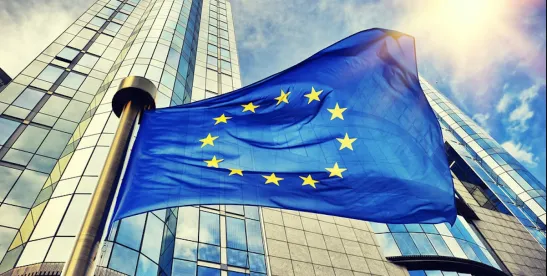This article provides an overview of the regulation of food-contact materials (FCMs), and plastics specifically, in the European Union (EU).1 As discussed below, plastics and their additives are currently the only types of FCM whose composition is specifically regulated at the EU level. We summarize below the general requirements applicable to all FCMs, followed by a more in-depth discussion of the additional requirements applicable to plastic FCMs marketed in the EU.
General Requirements under the Framework Regulation and GMP Regulation
In the EU, the so-called “Framework Regulation” (EC) No. 1935/2004 (Framework Regulation),2 sets forth general requirements for all food-contact materials. Among other requirements, the regulation requires that FCMs not transfer their constituents to food in quantities that could (a) endanger human health, (b) bring about an unacceptable change in the composition of food, or (c) bring about a deterioration in the organoleptic characteristics thereof. This regulation also requires that FCMs be produced in accordance with current Good Manufacturing Practices (GMP).
As envisioned in the Framework Regulation, the European Commission further articulated specific GMP requirements in the GMP Regulation (EC) No. 2023/2006. The GMP Regulation generally describes requisite quality assurance and quality control systems and documentation requirements for FCM manufacturing to ensure that materials and articles are consistently produced and conform to appropriate quality standards.
Specific Requirements under the Plastics Regulation
In contrast to the Framework and GMP Regulations, which are the extent of harmonized EU legislation applicable to many types of FCMs, The Plastics Regulation (EU) No. 10/2011, establishes very specific requirements for the manufacture of plastic materials and articles intended to contact food.
Scope
Materials that are subject to the requirements of the Plastics Regulation include:
- Materials and articles and parts thereof consisting exclusively of plastics;
- Plastic multi-layer materials and articles held together by adhesives or by other means;
- Materials and articles referenced above when printed or covered by a coating;
- Plastic layers or plastic coatings, forming gaskets in caps and closures, that together with those caps and closures compose a set of two or more layers of different types of materials; and
- Plastic layers in multi-material multi-layer materials and articles.
With few exceptions, the Plastics Regulation mandates that only those substances that are authorized and present on the “Union List” or positive list in the regulation are permitted to be used intentionally in the manufacture of plastic layers of plastic materials and articles contacting food. The types of substances that must be included on the “Union List” in order to be used in the production of food-contact plastics are:3
- Monomers or other starting substances;
- Additives excluding colorants;
- Polymer production aids (PPA) excluding solvents; and
- Macromolecules obtained from microbial fermentation.
Certain materials that fall outside the scope of the Plastics Regulation may still be used in the production of plastic layers of plastic materials and articles subject to national legislation or compliance with the Framework Regulation’s general safety clause, including:4
- Colorants;
- Solvents; and
- Aids to polymerization (ATP).
Nonintentionally added substances (NIAS, such as residual monomers and degradation byproducts) are also not subject to the positive list requirements but are subject to the safety requirements of the Framework Regulation.
The following materials are not subject to the requirements of the Plastics Regulation:
- Ion exchange resins;
- Rubber;
- Silicones;
- Coatings;
- Paper;
- Metal;
- Textiles;
- Adhesives; and
- Printing inks.
While not subject to the Plastics Regulation, the FCMs described above are subject to the overarching Framework Regulation, GMP Regulation, and, in specific cases, individual member state requirements.5
Demonstrating Compliance
In addition to meeting the compositional requirements of the Plastics Regulation, finished plastic materials and articles must also comply with specific migration limits (SMLs), which are applicable to individual substances or classes of substances identified on the Union List or associated annexes, and the overall migration limit. While no formal migration limits exist for substances on the Union List without an identified SML, or those substances that are not required to be listed, such as ATPs and NIAS, all substances found to migrate from plastic materials and articles contacting food must meet the general safety requirements of the Framework Regulation.
Declarations of Compliance
Products that are subject to the Plastics Regulation must also comply with declaration requirements in order to be placed on the market in the EU. A written declaration of compliance (DOC) is required to be available for plastic materials and articles, products from intermediate stages of their manufacture, and substances intended for use in the manufacture of those materials and articles at all marketing stages other than at the retail stage. As outlined in Annex IV of the Plastics Regulation, the scope of information required in such DOCs is quite extensive and includes administrative materials about the business operator and the product of interest, as well as materials generally summarizing the manner in which the product is permitted to be used. The DOC should also provide downstream users of the material adequate information about certain substances present in the finished product that may be subject to certain restrictions (e.g., SMLs) that require assessment, or for which genotoxicity has not been ruled out but that may migrate at levels in excess of 0.00015 mg/kg food.
Although the regulation of plastic food-contact materials has achieved greater harmonization at the EU level than other types of food-contact materials, the lack of complete harmonization, complex technical requirements for establishing compliance, and frequent amendments to the Plastics Regulation make regulatory assessments of food-contact plastics marketed in the EU a complex task. Our Health Care and FDA Practice Group has specialized Food Packaging and Food-Contact Materials experience to assist with such regulatory compliance assessments and all other requirements for the marketing of food-contact materials in the EU.
Footnotes
1 There are currently 27 EU member states: Austria, Belgium, Bulgaria, Croatia, Cyprus, Czech Republic, Denmark, Estonia, Finland, France, Germany, Greece, Hungary, Ireland, Italy, Latvia, Lithuania, Luxembourg, Malta, Netherlands, Poland, Portugal, Romania, Slovakia, Slovenia, Spain, and Sweden.
2 The formal name of the Framework Regulation is the Regulation (EC) No. 1935/2004 of the European Parliament and of the Council of 27 October 2004 on materials and articles intended to come into contact with food and repealing Directives 80/590/EEC and 89/109/EEC.
3 Article 3 of the Plastics Regulation includes the following definitions:
- Additive - “a substance which is intentionally added to plastics to achieve a physical or chemical effect during processing of the plastic or in the final material or article; it is intended to be present in the final material or article.”
- ATP - “a substance which initiates polymerization and/or controls the formation of the macromolecular structure.”
- PPA - “any substance used to provide a suitable medium for polymer or plastic manufacturing; it may be present but is neither intended to be present in the final materials or articles nor has a physical or chemical effect in the final material or article.”
- NIAS - “an impurity in the substances used or a reaction intermediate formed during the production process or a decomposition or reaction product.”
4 When reviewing the status of these materials under national legislation in the member states, the principle of “mutual recognition” is often implicated. Under mutual recognition, if a member state has legislation on ATPs, for example, and does not clear the specific ATP used in a plastic food-contact article, the product containing the ATP may still be marketed in that country if the product is first lawfully sold in another member state. This principle is tied to the principle of the free movement of goods under Articles 34-36 of the Treaty on the Functioning of the European Union.
5 For example, the Dutch Packaging and Consumer Articles Regulation from 1 July 2022, Italian Decree of 21 March 1973, and the Spanish Royal Decree n. 847-2011 on polymeric materials include provisions regulating materials that are not covered under the Plastics Regulation.





 />i
/>i
